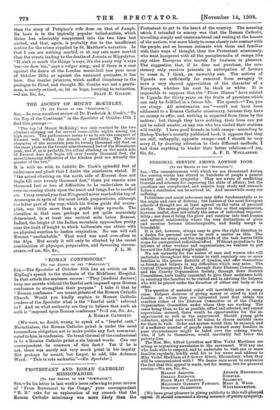"SALOME."
[TO TRI EDITOR Or Tab " sewn-con."] Six,—I observe in the Spectator of October 31st the following editorial comment upon the letter of Mr. F. G. Montagu- Powell :—"It is indeed curious to find that the inventions of mediaeval legend-mongers were as fantastic and as morbid as those of a decadent poetaster." Upon the assumption that the words " decadent poetaster" cannot be intended to designate the author of "Das Buch der Lieder," I would appeal to the authority of Heine to show that there is other evidence of a popular tradition much like that mentioned by your correspondent, and that that legend is capable of poetio treatment. The legend, which Heine knew, he put into verse in chap. 19 of " Attn. Troll." I quote the following stanzas because they contain what Heine considered that truth of
human nature which lay behind the legend. It may be noticed that Herodias, and not Salome, was the ghost who rode past Heine's lonely hunting-hut in the Pyrenees on her perpetual ride of penance for the murder of John the Baptist (St. Matthew xiv.) :—
" In den Hamden triigt sie Doch im Volke lebt die Sage immer Von Herodias blut'ger Liebe- Jene SchOssel mit dem Haupte Des Johannes, und sie kiisst es ; ja, sie kasst das Haupt mit
Inbrunst
Denn sie liebte einst Joban- nem—
In der Bibel steht es nicht
Of the whole chapter's poet 'c charm Professor Dr. Ernst Elster, editor of Heine's " Siimtliche Werke" (Leipzig und Wien : Bibliographisches Institut), speaks on p. 117. He has
been praising the wit and weird grace of Heine's attack on the Tendenzpoeten, and goes on :— " Am herrlichsten sind jene drei Frauenbilder gesehildert : die GOttin Diana, die Fee Abunde und die Herodias ; wer poetisch zu schauen vermag, wird gestchen, diese Figuren atehen lebend vor uns unser Auge entzackend und unser Herz bewegend, vor allem die Ethane Herodias mit ihrem, wie der Dichter sich so bezeichnend, ausdriickt glutenkranken ' Antlitz."
Without in any way committing myself to the approval of the
degradation of a great sacred tragedy to the position of a spectacle for the vulgar, a sensuous dance for the delectation of the average " Hans Liederlich," I would suggest that the legend in itself is neither decadent, nor necessarily monkish, nor blasphemous, and that it is not necessarily a theme which only a poetaster would invent. To the latter assertion Heine's poem is an answer. With regard to the tradition, it casts no shadow on the stainless figure of the Baptist, any more
Anders war ja unerklarlich Das Geltiste jener Dame- Wird sin Weib das Haupt bezebren
Eines Manna, den sie nicht liebt." than the story of Potiphar's wife does on that of Joseph. Its basis is in the typically popular ballad-notion, which Heine has admirably compressed into the two lines last quoted, and that, again, is probably due to the insufficient motive for the crime supplied by St. Matthew's narrative. In that I can see nothing morbid, or at any rate more morbid than the events leading to the deaths of Jocasta or Hippolytus. "It ain't so much the things 'e says, it's the nasty way 'e says 'em—or does 'em," says a vulgar song; and if 'there is a case against the dance at the London music-hall (see your issue of October 24th) or against the unnamed poetaster, it lies here. Our insular primness, which sniffed blasphemy in the prologue to. Faust, and thought Mr. Goethe was not a gentle- man, is surely extinct, or, let us hope, hurrying to extinction.











































 Previous page
Previous page